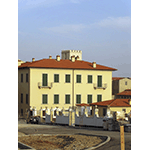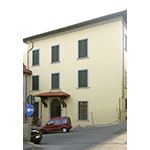Ospedale Vecchio di Piombino [Ancient Hospital of Piombino]
In 1810 the Baciocchi princes inaugurated a new hospital in Piombino, to replace the old Hospice of the San Giovanni di Dio Monastery (existing since 1576), deemed no longer adequate. The new hospital complied with the most modern standards set by the Paris General Counsel of Hospices. In 1805, in fact, the architect Clavereau had declared that "a hospital should be built on the slope of a hill, on which are found abundant sources of good water". The chosen site was the former convent of Santa Anastasia, overlooking the sea and thus exposed to ventilation and abundant light, factors considered determinate for the cure of many diseases. The building was also situated near the medieval public springs, known as the Fonti di Marina (still visible today), to ensure a good water supply; but in 1853 it became necessary to install a suction pump to convey water from the historic Piombino springs.
When the Principality of Piombino was absorbed by the Grand Duchy of Tuscany in 1815, the hospital became an important medical centre for this part of Maremma, where the population suffered not only from widespread malaria but also from lung diseases and skin disorders as well as epidemics of typhus, smallpox and cholera. In 1811 a "Healthcare House" at the port was planned to protect the population "from the disastrous effects of contagious diseases", such as the terrible epidemics of petechial typhus (1815-1817) and cholera (1854-1855). The hospital was the first in Europe to provide smallpox vaccination, made compulsory through a decree issued in 1806 by Elisa Bonaparte Baciocchi.
Today the only remaining trace of the Old Hospital of Piombino is the building complex currently being remodelled for residential use.
****************************
Texts by Antonella Gozzoli
English translation by Catherine Frost
Last update 06/feb/2008





